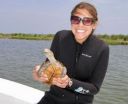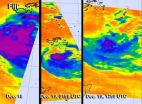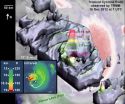(Press-News.org) (December 19, 2012) Look out the window and you're likely to see the dispersal of seeds—dandelion tufts in the wind, a squirrel burying an acorn, a robin flying off with a dogwood fruit. You might even have a burr "velcroed" to your sock.
Sarah Sumoski, a recent graduate of the Virginia Institute of Marine Science, has now published a study of seed dispersal in a less-familiar environment—the eelgrass beds of Chesapeake Bay. The study—the first to show that marine animals can disperse eelgrass seeds—appears as the featured article in today's issue of Marine Ecology Progress Series. It is co-authored by Dr. Robert "JJ" Orth, head of the Seagrass Monitoring and Restoration program at VIMS and Sumoski's major professor in the College of William and Mary's School of Marine Science at VIMS.
Eelgrass—like other seagrasses—is a flowering plant that reproduces both by sending out rhizomes (like crabgrass) and producing tiny underwater seeds (like the fescues of many lawns). Eelgrass beds play a key ecological role in Chesapeake Bay and other coastal ecosystems but are in decline worldwide due to cloudy waters, warm temperatures, and excess nutrients that encourage the growth of light-stealing algae.
Understanding how seagrass seeds are dispersed is important for guiding efforts to restore seagrass meadows in Chesapeake Bay and other coastal ecosystems, and for informing the models that are used to guide seagrass management plans and restoration efforts.
"Traditional thinking is that eelgrass disperses by abiotic mechanisms such as floating seeds, floating reproductive shoots, or currents pushing seeds along the seafloor," says Sumoski. "Our study shows that eelgrass seeds can also be dispersed through consumption and excretion by fish, terrapins, and birds—providing a means to bring seeds to isolated areas unlikely to receive seeds via abiotic mechanisms. In fact, we think the distance a seed travels via biotic dispersal may rival or exceed the distances recorded from abiotic mechanisms."
Sumoski and Orth conducted the study through 3 years of painstaking laboratory experiments in which they fed 1,707 eelgrass seeds to animals often found in and around eelgrass beds—3 fish species (northern puffers, pinfish, and mud minnows or mummichogs), diamondback terrapins, and a seabird, the lesser scaup. Previous studies have recovered eelgrass seeds from the stomachs of these or similar species, and all 5 have been observed feeding in eelgrass beds, making deliberate or inadvertent ingestion of eelgrass seeds likely.
Sumoski then retrieved seeds—each smaller than a rice grain—from the animals' feces, noted their condition, and planted intact seeds in experimental tanks containing sediments and water from the York River near VIMS' riverside campus in Gloucester Point, Virginia.
The results of their experiments showed that the seeds were able to survive passage through the gut of all the animals studied, with excretion and germination rates highest for mummichogs and northern puffers, moderate for pinfish and diamondback terrapins, and lowest for scaup.
They also calculated how far the animals might be able to carry the seeds, by measuring how long it took the seeds to pass through the gut of each species, and multiplying those values by reported swimming or flying speeds for each creature.
"We estimate that the fishes could disperse eelgrass seeds 10s to 100s of meters, while the maximum dispersal distance for terrapins is around 1,500 meters, or about a mile," says Sumoski. "The scaup was the champ, with a maximum dispersal distance of more than 10 miles."
Physical mechanisms have been shown to disperse eelgrass seeds similar distances: 10s of meters for seeds moved along the seafloor by currents, 100s of meters for individual floating seeds, and more than 100 kilometers for intact flowering shoots, which can float on the surface for weeks and contain multiple seeds. Sumoksi points out, however, that "the animals are likely to be more effective dispersal agents, as they prefer to live under the conditions that favor seagrass growth and thus will tend to carry seeds to areas where they'll germinate. Wind and currents can easily disperse seeds into areas unsuitable for seagrass growth."
Sumoski adds that dispersal of seagrass seeds by animals not included in her study—such as manatees, dugongs, and green turtles—could carry seeds of seagrass species found in tropical waters for distances greatly exceeding those of abiotic mechanisms.
Overall, she says, "While seeds will suffer mortality through ingestion and digestion, some proportion can be expected to survive, germinate, and grow to adult plants, meaning that dispersion by animals can lead to re-colonization of past eelgrass meadows, or even the colonization of new habitats. That's good news for eelgrass beds and the organisms that rely on them for habitat, nursery grounds, and food."
INFORMATION:
Study reveals that animals contribute to seagrass dispersal
Fish, terrapins, and birds may help spread eelgrass seeds into new areas
2012-12-20
ELSE PRESS RELEASES FROM THIS DATE:
Time series of infrared NASA images show Cyclone Evan's decline
2012-12-20
Cyclone Evan is now far south of Fiji and wind shear and cooler sea surface temperatures have been taking their toll on the storm and weakening it. Infrared data from NASA's Aqua satellite has shown a quick decline in the storm's structure over one day.
A time series of infrared images from the Atmospheric Infrared Sounder (AIRS) instrument that flies aboard NASA's Aqua satellite showed changes in intense thunderstorms within Cyclone Evan between Dec. 18 and Dec. 19. Over a time period of 36 hours, Evan weakened from Cyclone strength to Tropical Storm strength. In an ...
NASA satellite finds an unusually tall storm-cell in Cyclone Evan
2012-12-20
NASA's Tropical Rainfall Measuring Mission or TRMM satellite found an unusually tall towering thunderstorm in Cyclone Evan.
According to Owen Kelley of the TRMM satellite team at NASA's Goddard Space Flight Center in Greenbelt, Md, the most startling feature of the December 16 overflight of Tropical Cyclone Evan was the extremely tall storm-cell in the north side of the eyewall. At the time TRMM passed overhead and captured an image of the storm, Evan was about to rake across the northern coast of the islands of Fiji.
The updrafts in this tower extended high enough ...
Why our backs can't read braille
2012-12-20
Johns Hopkins scientists have created stunning images of the branching patterns of individual sensory nerve cells. Their report, published online in the journal eLife on Dec. 18, details the arrangement of these branches in skin from the backs of mice. The branching patterns define ten distinct groups that, the researchers say, likely correspond to differences in what the nerves do and could hold clues for pain management and other areas of neurological study.
Each type of nerve cell that the team studied was connected at one end to the spinal cord through a thin, wire-like ...
NASA's Operation IceBridge data brings new twist to sea ice forecasting
2012-12-20
Shrinking Arctic sea ice grabbed the world's attention again earlier this year with a new record low minimum. Growing economic activity in the Arctic, such as fishing, mineral exploration and shipping, is emphasizing the need for accurate predictions of how much of the Arctic will be covered by sea ice. Every June, an international research group known as the Study of Environmental Arctic Change (SEARCH) publishes a summary of the expected September Arctic sea ice minimum known as the Sea Ice Outlook. The initial reports and monthly updates aim to give the scientific community ...
LSUHSC research discovery provides therapeutic target for ALS
2012-12-20
New Orleans, LA –Research led by Dr. Udai Pandey, Assistant Professor of Genetics at LSU Health Sciences Center New Orleans, has found that the ability of a protein made by a gene called FUS to bind to RNA is essential to the development of Amyotrophic Lateral Sclerosis (ALS). This discovery identifies a possible therapeutic target for the fatal neurological disease. The research will be available online in the Advanced Access section of the journal Human Molecular Genetics website, posted by December 21, 2012. It will be published in an upcoming issue of the journal.
...
Small changes in eating prompts weight loss
2012-12-20
Making small easy changes to our eating habits on a consistent basis - 25 days or more per month - can lead to sustainable weight loss, according to research by Professor Brian Wansink in Cornell University's Food and Brand Lab. The challenge is to figure out which changes work for specific individuals and how to stick with changes long enough to make them second nature.
To explore this issue, Cornell researchers launched the National Mindless Eating Challenge (NMEC), an online healthy eating and weight loss program that focused on simple eating behavior changes, instead ...
MicroRNAs present exciting opportunities for cancer therapy and diagnosis
2012-12-20
Amsterdam, NL, December 19, 2012 – As many as 50 percent of all human protein-coding genes are regulated by microRNA (miRNA) molecules. While some miRNAs impact onset and progression of cancer, others can actually suppress the development of malignant tumors and are useful in cancer therapy. They can also serve as potential biomarkers for early cancer detection. In a new issue of Cancer Biomarkers, investigators report on non-coding miRNAs as appealing biomarkers for malignancy.
"MiRNA-based therapies are attractive partly due to the fact that these molecules can target ...
California's graduate students in environmental sciences lag behind in technology, computation
2012-12-20
RIVERSIDE, Calif. — Researchers at the University of California, Riverside have conducted a study showing that many skills and practices that could help scientists make use of technological and computational opportunities are only marginally being taught in California's formal graduate programs in the environmental sciences.
The researchers found, too, that graduate students in the state were, in general, not engaged in data management practices. Of the students surveyed who had already completed their graduate degree, only 29.3 percent had made their research data products ...
Delusions of gender: Men's insecurities may lead to sexist views of women
2012-12-20
He loves her, he loves her not.
A new study led by Joshua Hart, assistant professor of psychology, suggests that men's insecurities about relationships and conflicted views of women as romantic partners and rivals could lead some to adopt sexist attitudes about women.
The study was recently published in Personality and Social Psychology Bulletin, a peer-reviewed journal.
Hart and his co-authors, Jacqueline Hung '11, a former student of Hart's, and psychology professors Peter Glick of Lawrence University and Rachel Dinero of Cazenovia College, surveyed more than 400 ...
Young offenders who work, don't attend school may be more antisocial
2012-12-20
Many high school students work in addition to going to school, and some argue that employment is good for at-risk youths. But a new study has found that placing juvenile offenders in jobs without ensuring that they attend school may make them more antisocial.
The study, by researchers at the University of Pittsburgh, Temple University, and the University of California, Irvine, appears in the journal Child Development.
While evidence suggests that working long hours during the school year has negative effects on adolescent antisocial behavior among middle- and upper-income ...
LAST 30 PRESS RELEASES:
NTP-enhanced lattice oxygen activation in Ce-Co catalysts for low-temperature soot combustion
Synergistic interface engineering in Cu-Zn-Ce catalysts for efficient CO2 hydrogenation to methanol
COVID-19 leaves a lasting mark on the human brain
Scientists use ultrasound to soften and treat cancer tumors without damaging healthy tissue
Community swimming program for Black youth boosts skills, sense of belonging, study finds
Specific depressive symptoms in midlife linked to increased dementia risk
An ‘illuminating’ design sheds light on cholesterol
Who is more likely to get long COVID?
Study showcases resilience and rapid growth of “living rocks”
Naval Research Lab diver earns Office of Naval Research 2025 Sailor of the Year
New Mayo-led study establishes practical definition for rapidly progressive dementia
Fossil fuel industry’s “climate false solutions” reinforce its power and aggravate environmental injustice
Researchers reveal bias in a widely used measure of algorithm performance
Alcohol causes cancer. A study from IOCB Prague confirms damage to DNA and shows how cells defend against it
Hidden viruses in wastewater treatment may shape public health risks, study finds
Unlock the power of nature: how biomass can transform climate mitigation
Biochar reshapes hidden soil microbes that capture carbon dioxide in farmland
Reducing saturated fat intake shows mortality benefit, but only in high-risk individuals
Manta rays create mobile ecosystems, study finds
Study: Mixed results in using lipoic acid to treat progressive multiple sclerosis
Norbert Holtkamp appointed director of Fermi National Accelerator Laboratory
New agentic AI platform accelerates advanced optics design
Biologists discover neurons use physical signals — not electricity — to stabilize communication
Researchers discover that a hormone can access the brain by hitchhiking
University of Oklahoma researcher awarded funding to pursue AI-powered material design
Exploring how the visual system recovers following injury
Support for parents with infants at pediatric check-ups leads to better reading and math skills in elementary school
Kids’ behavioral health is a growing share of family health costs
Day & night: Cancer disrupts the brain’s natural rhythm
COVID-19 vaccination significantly reduces risk to pregnant women and baby
[Press-News.org] Study reveals that animals contribute to seagrass dispersalFish, terrapins, and birds may help spread eelgrass seeds into new areas





